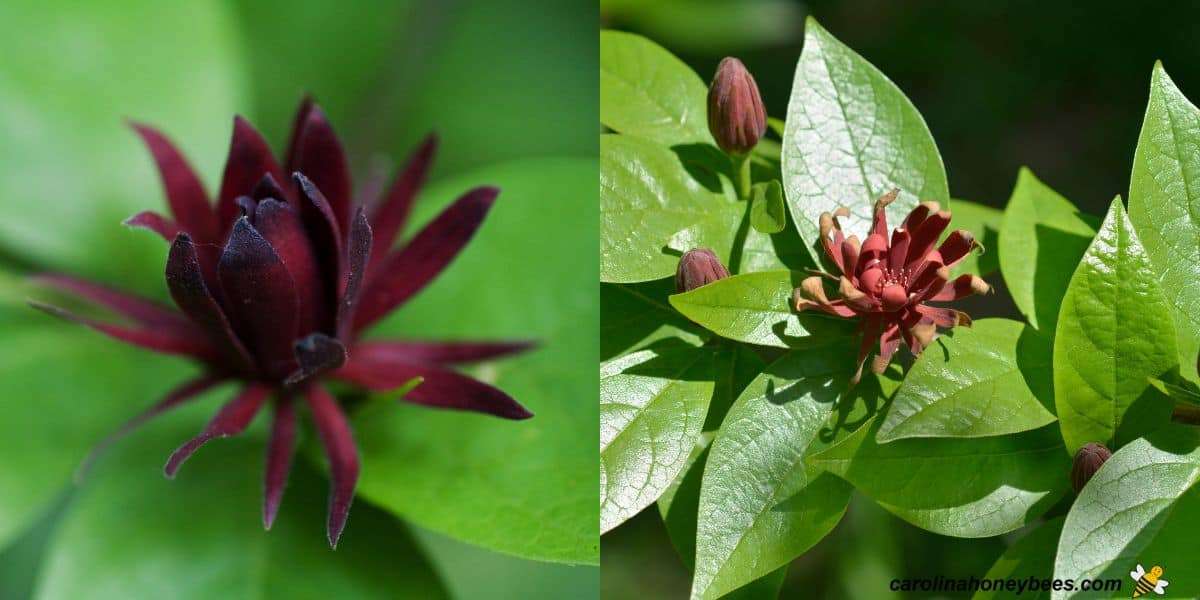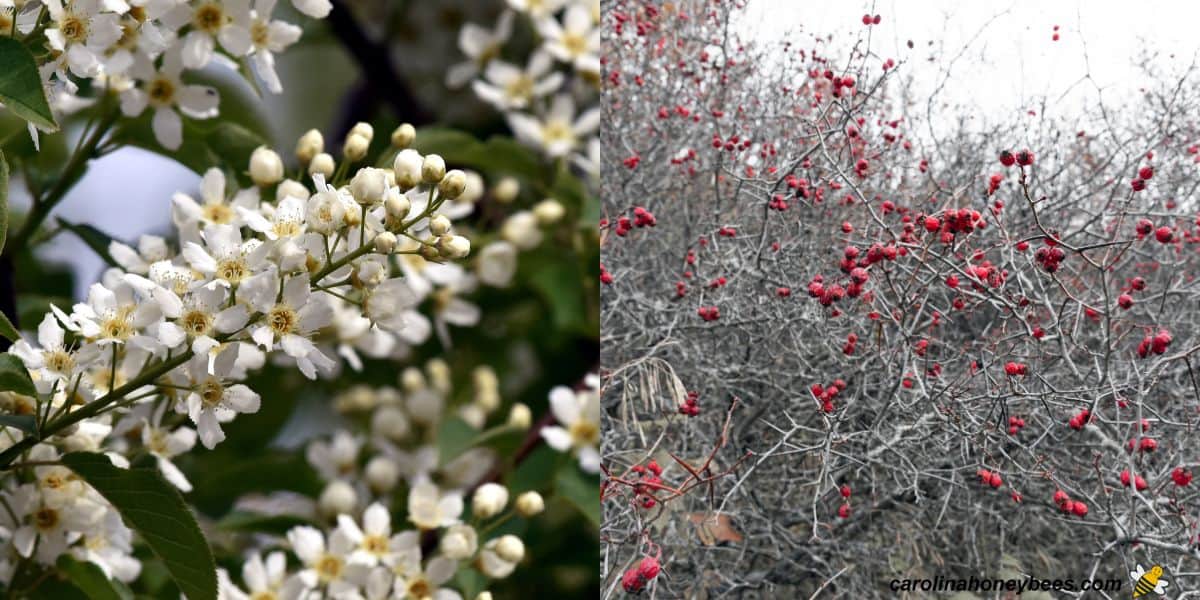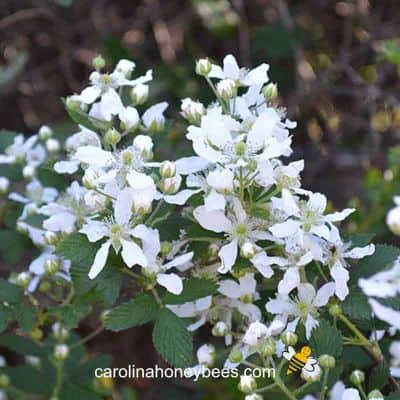Bee Bushes & Shrubs
If you are looking for a flowering bee bush or shrub to add to your yard, this guide will help you make the best selection. Even small areas can become a bee oasis-when the right variety of plants are chosen. A bee friendly bush or shrub can provide nectar or pollen or both. You will not only be helping honey bees but many other important insects in your area as well.

If you want to make the maximum impact, diversity is the key for best food sources. Be sure to choose bee garden plants with different types of flowers in a variety of shapes and colors.
Shrubs that Attract Bees
Flowering plants provide much needed food for bees, but they help in other ways too. Their foliage may provide food and shelter for other pollinators and nesting sites for birds.
Nectar and pollen from different plants varies in chemical composition. This is great for a bee’s diet. Honey bees should eat food with a variety of nutritional factors – just like us.
Bushes vs Shrubs
What is the difference between a bush that is attractive to bees vs a shrub? Most gardeners will say there is no difference – the terms are used interchangeably.
Technically, a plant that is thick all the way to the ground is considered a bush – where a taller plant that is not so thick near the ground is considered a shrub.
Top Shrubs to Include in Your Bee Garden
Here is a guide to some of the most common flowers bushes and shrubs to consider for a bee friendly landscape. Some are found growing across the entire US, while others only grow in certain regions.
You may be surprised to find a number of native flowering shrubs in your region. They tend to blend into the background for most of the year. But, they are rather striking when in flower.
Search out your local nurseries-as they are best equipped to advise you on selection. A selection of natives and commercial hybrid varieties works well also.
Bee-Brush (Aloysia gratissima)
Bee-Brush (Whitebrush) is a shrub found in the desert areas of the South Western US. The beautiful white flowers are very attractive to honey bees. They may even make a honey crop in areas with lots of bloom.
It is also very attractive to butterflies. However, it can be rather unruly and form dense thickets without good pruning. While providing good cover for many animals, it is toxic to horses and other forms of livestock.

Buttonbush (Cephalanthus occidentalis)
Buttonbush is a common site in New England. But, this native shrub for bees grows well across a many parts of the country.
From Alabama to California, this shrub has several types and loves wet conditions. It is even salt tolerant.
Button bush is especially attractive to pollinators with longer tongues such as butterflies – but bees visit it too. Great for mass plantings or naturalizing.

Carolina Allspice (Calycanthus floridus)
Sometimes called Bubby Bush, Spice Bush or Sweetshrub, this plant is native to the Appalachians south of New England.
This bee friendly native shrub has small blooms that are not very noticeable. But, the leaves and blooms are fragrant when crushed and were often used to make potpourri.

Carolina Rose (Rosa Carolina)
Carolina Rose, also called “Pasture Rose”, is a deciduous shrub that grows well in a wide variety of soil conditions.
Native the the Eastern half of the United States, it is beneficial to many pollinators and wildlife too-providing habitat.
This shrub is deer resistant and even though it likes moist soil, it is drought tolerant. However, it does have many thorny branches so keep that in mind when planting. A good choice for a naturalized area or a rain garden to control erosion.

Chokecherry (Prunus virginiana)
This blooming shrub is native to most regions of the United States. It is highly adaptable to many different soil types.
The beautiful white flowers bloom in mid-summer and are very attractive to bees. The berries produced feed other types of wildflower later in the season.

Elderberry (Sambucus nigra)
There are several varieties of Elderberry. Most are native to the Eastern and mid-sections of the United States. Elderberry is an excellent native shrub for bees providing both pollen and nectar.
The resulting berries from ample bee pollination are enjoyed by wildlife (birds, small animals etc). And, many people harvest the berries and use them to make wine, jams or homeopathic medicines.

Oregon Grape – Mahonia (Berberis aquifolium)
A slow growing holly-like shrub, Oregon Grape is evergreen. It grows naturally in western North America but can be grown almost anywhere. This plant makes an impressive barrier to unwanted visitors.
It retains tough spikey leaves year-round. Don’t plant it near a walkway, even though it grows slowly, the ends of the leaves are prickly.
A popular shrub in landscaping, both native and cultivated types are available. The wild type is often used in reforestation projects.
Oregon Grape produces a blue fruit in late Summer that is enjoyed by various types of wildlife. But, it is the bloom that makes it one of the best bushes for bees.
In late Winter, the shrub comes alive with bright yellow bell shaped flowers. This is during a time when few other food sources are available.
It is a very showy display and gives off a sweet fragrance. My honey bees, flock to the blooms to collect much needed food. I have seen it in flower during a snowy time.

Pussy Willow (Salix discolor)
Pussy Willow is a narrow upright growing shrub, this native serves as an important early season pollen source for honey bees and native bees.
There are many varieties of this shrub with many being native to the northern half of the United States. However, many of them grow well in other regions. It is good to cut them back every few years to encourage growth of new stems.
The native Pussy Willows (Salix discolor) is one of my favorite bee bushes. They look so nice in late Winter. But, most of the fancy hybrids, such as weeping willows, are of little value to pollinators.

Serviceberry (Amelanchier stolonifera)
Dwarf Serviceberry is a low maintenance shrub that is great for native gardens. It is native to the northeastern and north-central United States.
The flowers are attractive to bees and other pollinators and like Highbush Blueberry, it offers beautiful Fall color.
With very little pruning required, this well-behaved native shrub is a great addition to your bee garden. There are other types of that can be a pain to manage – check your variety when purchasing.

Winged Sumac (Rhus copallinum)
There are many varieties of Sumacs. It is one of the valuable native shrubs for bees. This plant does need a bit of space.
It may stay small and bushy or grow up to 20 feet tall and form a thicket. If you have the space, it is very valuable to pollinators and could a nice addition to a natural planting area.

Why Flowering Bushes Are Good for Bees & Homeowners
You may wonder why you should consider planting bushes for bees or flowering shrubs that attract pollinators? You might like helping bees but what’s in it for you?
Fortunately, these landscape plants add value and beauty to your outdoor space. They can be a natural living privacy fence for your backyard too.
Compared to a flower, a large bush in bloom can provide a lot of food for hungry insects. This helps worker honey bees collect resources nearby. Hives are more productive when the bees do not have to travel far to food sources.

Other Bee Friendly Shrubs
Of course, there are hundreds more bushes that flower and benefit bees. Some of these can be invasive plants that bees visit – ask your local extension if any of them are a bad idea for your region.
- Black Sage (Salvia mellifera)
- Black Willow (Salix nigra)
- Buddleia/Buddleja – Butterfly bushes (only some)
- California Buckeye (Aesculus californica)
- Canyon Gooseberry (Ribes menziesii)
- Ceanothus – California lilac
- Clethra – Ruby Spice
- Cliff Fendlerbush (Fendlera rupicola)
- Downy Serviceberry (Amelanchier arborea)
- Dwarf Coastal Manzanita (Arctostaphylos edmundsii)
- Eastern Teaberry (Gaultheria Procumbens)
- Flowering Raspberry (Rubus odoratus)
- Holly – Ilex spp
- Lemonade Sumac (Rhus integrifolia)
- Ligustrum vulgare – Common Privet (invasive)
- Pyracantha Orange Glow
- Mountain Pepperbush (Clethra acuminata)
- Meadow Sweet (Spirea alba)
- Weigela (some varieties)
- Western Snowberry (Symphoricarpos occidentalis)
- Witch Hazel (Hamamelis virginiana)
A Final Word
While many flowering shrubs are attractive to bees, this is not true for all. Some flowers even repel honey bees. And while not a big problem, there are flowering plants toxic to bees. Before investing in new plants, do your research to find the best options for your climate and space. And, if you have the room – top trees for bees.


